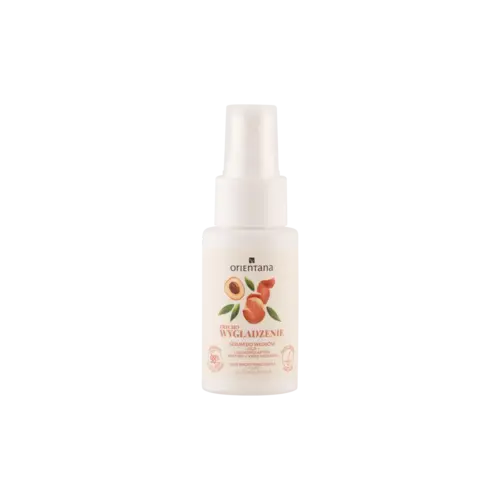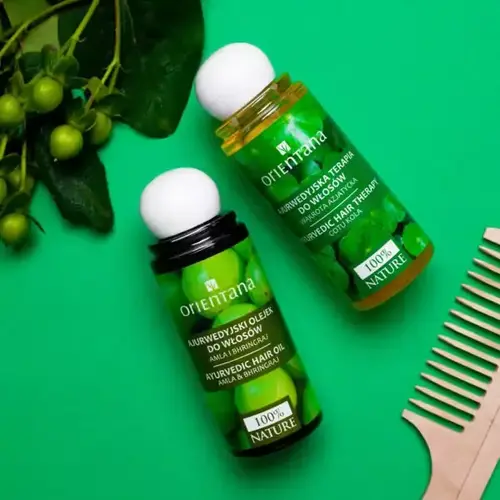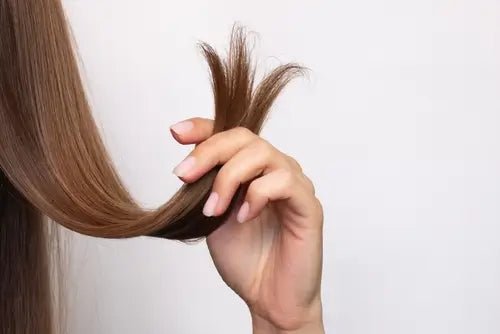Split ends, also known as trichoptilosis , are a common hair structure problem that involves the splitting of the hair shaft at the end. Although often seen as merely an aesthetic defect, split ends are also a symptom of weakened hair on a structural level, resulting from mechanical, chemical, and environmental factors. Split ends affect everyone at some point in their life.
The main scientific cause of split ends is damage to the hair's protective layer, the cuticle , which is made up of overlapping keratin cells. When this barrier is weakened, the inner layers of the hair, the cortex and the medulla , are exposed, which leads to them splitting.
The most common causes of damage to the cuticle include frequent chemical treatments, such as dyeing, bleaching or permanent waves, as well as heat styling (hair dryers, straighteners, curlers), mechanical friction (e.g. combing wet, tangled hair, sleeping with loose hair) and exposure to UV radiation. These are the reasons why split ends can appear.
To prevent them, it is worth trimming your hair regularly, ideally every 6-8 weeks. You should also use cosmetics rich in emollients, which smooth the hair surface and strengthen its structure.
It is also crucial to limit harmful treatments and protect hair from external factors, e.g. with a head cover in the summer or a silk pillowcase. Incorporating conditioners and masks containing Fiberhance™ BM solution and vegetable oils into your care can significantly improve the condition of your hair and reduce the risk of splitting.

Understanding the biological basis of this phenomenon allows you to not only take better care of your hair, but also effectively prevent further damage.
Split ends - Causes
Split ends ( trichoptilosis ) are the result of structural degradation of the hair shaft, which can result from a number of overlapping factors. This damage is both physical and chemical, and can also be the result of an improper diet or improper hair care. Understanding the causes of split ends is key to implementing effective prevention and hair care.
Hair Care Mistakes
One of the main factors leading to split ends is improper hair care. This primarily concerns excessive washing of hair with aggressive shampoos that contain sulphates (SLS, SLES), which can strip hair of its natural protective lipids. Therefore, when caring for split hair, it is worth choosing shampoos without SLS such as Ginger and Lemongrass Shampoo, Jasmine and Almond Shampoo, or Neem and Green Tea Shampoo.

Excessive hair washing and failure to use thermal protective cosmetics when styling cause micro-damage to the hair cuticle , which causes hair ends to dry out and split. Studies show that hair regularly exposed to high temperatures (over 150°C) shows a significant deterioration in the structural integrity of keratin, which translates into increased brittleness and susceptibility to splitting. A good solution is to use Trycho Lychee serum , which will protect the hair and protect it from brittleness. Improper hair care also includes not trimming the hair regularly.
Mechanical damage

Equally important are mechanical damages, which include, among others, incorrect brushing (especially of wet hair), vigorous rubbing with a towel, as well as rubbing against clothes or bedding.
Wet hair is much more susceptible to stretching and breakage – according to research, the structure of wet hair fibers can extend by up to 30%, making them more susceptible to mechanical damage. Regular use of tight hairstyles or inappropriate accessories (e.g. rubber bands with metal elements) also increases the risk of split ends. It is therefore worth stocking up on silk rubber bands and good hair brushes and combs.
Exposure to external factors
The influence of environmental conditions is also significant. UV radiation, especially UVA, has the ability to penetrate the hair cuticle and degrade its cortex by oxidizing keratin proteins and lipids. As a result of this process, hair becomes brittle, dull and more susceptible to splitting. In addition, the effects of strong wind, low temperatures and dry air promote moisture loss and weaken the hair structure.
Chemical treatments
Chemical treatments such as dyeing, lightening or permanent waving are among the most common factors contributing to structural damage to hair. During the dyeing and lightening process, hair cuticles are opened to introduce pigments or oxidants, which is associated with a permanent disruption of the continuity of the sheath and a reduction in the content of fibril proteins and intercellular lipids. Studies have shown that after a single lightening treatment, keratin loses up to 20% of its initial protein mass, which significantly destroys the structure of hair ends.
Split ends from Vitamin and mineral deficiency
An improper diet can also affect the condition of the hair, including susceptibility to splitting. Deficiencies of B vitamins are particularly important, especially Biotin (vitamin B7). Lack of the appropriate level of vitamin A and E and elements such as iron, zinc and silicon significantly affect the structure of hair ends.
Biotin is involved in the keratinization process, and its deficiency results in a weakening of the hair structure. Zinc and iron play a key role in the proliferation of hair follicle cells and the synthesis of fibrous proteins - their deficiency can lead to a decrease in hair thickness and elasticity, and thus increased brittleness and split ends. Damaged hair very often results from nutritional deficiencies.
Split ends from henna?
Henna hair is a natural method of coloring and care that is very popular due to its strengthening and regenerating properties. However, if henna is used incorrectly or the frequency of treatments is too high, a problem that many people who care for their hair struggle with may occur - split ends .
Why can henna cause split ends?
Henna powder (Lawsonia inermis) itself does not destroy the hair structure, on the contrary - thanks to the content of lawsone it creates a thin, protective layer on the hair surface, which strengthens the shaft and improves its elasticity. However, certain factors related to the entire henna process can negatively affect the condition of the ends:
- Dry hair - henna has a slightly astringent effect and, if used frequently, can dehydrate particularly dry and porous parts of the hair, including the ends. Dryness promotes brittleness and splitting of keratin fibers. Some women who henna their hair notice split ends.
- Lack of proper hydration after henna application - applying henna alone without supplementing emollient and humectant care may lead to loss of hair elasticity and susceptibility to mechanical damage.
- Too frequent henna - frequent applications can cause the so-called over-protein effect, i.e. excessive stiffening and brittleness of hair fibers. Stiffened ends are more susceptible to mechanical splitting.
- Incorrect application technique - not gently spreading the mixture, intensive combing of the hair while applying or rinsing henna can mechanically damage the ends and initiate the splitting process.
How to henna your hair to avoid split ends?
To enjoy the benefits of henna and at the same time avoid the problem of split ends , it is worth following a few rules:
- After hennaing, use moisturizing masks and conditioners with humectants (e.g. aloe, glycerin) and emollients (vegetable oils, butter).
- Do not apply henna too often – usually once every 4–6 weeks is enough.
- When applying henna, be gentle with your hair, avoid tugging or rubbing vigorously.
- Regularly protect the ends with plant silicones or light oils to protect them from moisture loss and mechanical damage.
Split ends after henna are not caused by henna itself, but by care errors and improper application techniques. A properly performed henna treatment not only does not damage the ends, but can actually improve their condition, giving the hair shine, thickness and elasticity. The key is the balance between strengthening and moisturizing, as well as gentleness in everyday hair care.
What are the ways to deal with split ends?
Due to the fact that split ends are irreversible damage to the hair structure, there is no method to permanently "glue" them. Therefore, prevention is crucial, which involves both the physical removal of damaged hair fragments and the use of protective and care activities that minimize the risk of further splitting. In trichological and cosmetological literature, there are several effective methods that have a beneficial effect on the condition of the ends and the whole hair. Here are the ways to deal with split ends.
Regular hair trims
The easiest and most effective way to eliminate split ends is to regularly remove them by trimming your hair. It is recommended to trim damaged hair every 6-8 weeks, as the damage tends to "migrate" up the hair shaft, further weakening its structure.
According to research conducted by the American Academy of Dermatology (AAD), trimming your hair regularly does not affect its growth rate, but it significantly improves its overall aesthetics and reduces breakage. Let's observe when the ends of the hair are drying out and trim them more often.
Hair styling - thermal protection
The use of thermal protective cosmetics before using devices that emit high temperatures (such as straighteners, curling irons or dryers) is an important element of prevention. These products create a protective layer on the hair surface, which limits the penetration of heat into the interior of the fiber and reduces keratin damage.
Studies have shown that properly selected products can protect healthy hair and reduce protein degradation by up to 30–50% during exposure to temperatures of 200°C. The content of polymers and proteins in such cosmetics also strengthens the sealing function of the hair shaft. In exceptional cases, it is recommended to discontinue styling treatments using very high temperatures.
Split ends - application of oils
Damaged hair will thank you for oils. Oiling hair on the entire hair and ends has a beneficial protective and regenerative effect. Avocado oil, castor oil, coconut oil, jojoba oil or linseed oil have the ability to penetrate the hair structure and replenish lipid deficiencies.
Coconut oil is particularly valued, as it has the ability to penetrate deep into the hair cortex and reduce protein loss thanks to its low molecular weight and the presence of lauric acid. It is worth regularly oiling the scalp and rubbing the remaining oils into split ends.

Hair Therapy Strengthening
A natural, intensively regenerating therapy created according to the principles of Indian Ayurveda. It is a comprehensive treatment for weakened hair that requires strengthening, nourishment and stimulation for growth. It works very well on split ends and is worth reaching for.
The composition includes unique Ayurvedic herbs:
- Gotu Kola (Asian Pennywort) – stimulates microcirculation and the production of collagen and elastin, which translates into greater density and elasticity of the scalp and better hair growth.
- Amla – Indian gooseberry with strong anti-inflammatory properties, strengthens hair follicles and prevents hair loss.
- Neem – cleanses, has antifungal and antibacterial properties, reduces dandruff and oiliness of the scalp.
- Sesame oil and coconut oil - excellent emollients that nourish and strengthen hair.
The formula rich in natural oils and herbal extracts restores hair strength, healthy appearance and shine as well as strengthens the structure of hair ends. The therapy is especially recommended for problems with hair loss and weakening, as well as a care ritual inspired by Indian tradition.
Ayurvedic Amla and Bhringraj Hair Oil Density
A unique oil created in accordance with the principles of Ayurveda, based on nourishing sesame oil and strongly regenerating Indian herbs: amla and bhringraj. It is a real plant bomb for damaged, falling out and dull hair. Split ends will thank you many times for this oil.
The most important active ingredients:
- Bhringraj – called the “king of hair”, prevents hair loss and greying, soothes the scalp, reduces dandruff and restores comfort.
- Amla – rich in vitamin C, nourishes hair follicles, prevents breakage and split ends, adds density.
- Sesame, coconut and sweet almond oil – intensively moisturize, strengthen the hair structure and protect against damage.
- fenugreek oil, holy basil, neem – support hair growth, have anti-inflammatory and antibacterial properties.
Regular use of the oil significantly improves the condition of the scalp, stimulates the growth of new hair and gives it silky softness and shine. As soon as you feel that the ends of your hair are drying out, it is worth performing a hair oiling treatment.
Hair lamination
Lamination is a care treatment that involves covering the hair with a layer of film-forming substances (e.g. gelatin, wheat proteins or collagen), which fill micro-gaps in the hair structure and make it smooth and elastic. The effect of the treatment is visible smoothing, shine and temporary "gluing" of split ends. Although the effect is not permanent and usually lasts for several washes, regular use of lamination can improve the condition of the hair and minimize its susceptibility to split ends.
Changing your care habits
Isn't it time to change your hair care routine? Long-term prevention of split ends requires changing your daily hair care habits. This includes, among others, gently washing your scalp and hair with mild detergents (e.g. without SLS/SLES), avoiding hot water and excessive friction when drying. It is recommended to use shampoos, conditioners and masks with moisturizing and rebuilding effects.
Our latest hair cosmetic prepared together with a trichologist is a conditioner-mask, the formula of which works to repair damaged and weakened strands, rebuilding their structure and strengthening them from the inside. It is also worth reaching for a moisturizing shampoo (without SLS/SLES/ALS and CB), which is rich in humectants.
In addition, it is important to use soft accessories for combing (e.g. wet brushes) and avoid tight hairstyles that can cause micro-damage to the hair structure. Avoid excessive washing of the hair with aggressive shampoos.
I hope that from today split ends will no longer be your problem and you will regain healthy hair.






